December 14, 2019
Download as PDF
View on Hyperallergic
The Swiss artist Nicolas Party is both the subject and curator of Pastel, an extraordinary exhibition examining the under-appreciated, fugitive medium and its history.
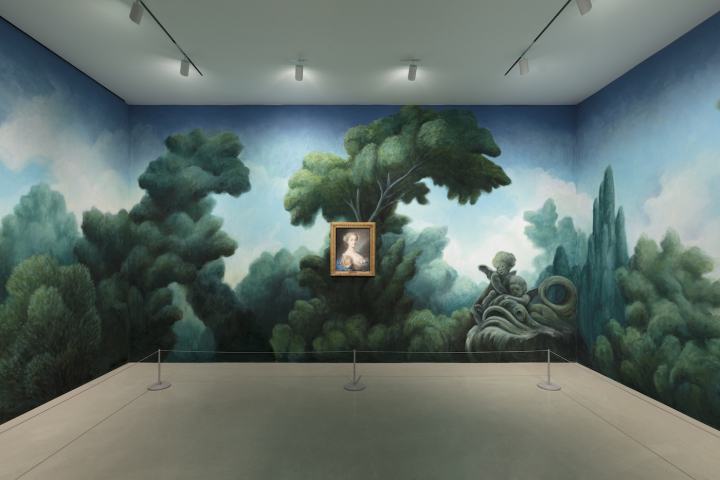
“Nicolas Party: Pastel” at The FLAG Art Foundation, installation view: Rosalba Carriera, “Portrait of a Lady at Three-Quarter Length” ( n.d.), pastel on paper, 22 × 17 1⁄4 inches, Collection of Nicolas Party (in frame); Nicolas Party, “From Jean Honoré Fragonard, The Progress of Love, 1773” (2019), soft pastel on wall, 918 × 134 inches (mural); (all installation photos courtesy The FLAG Art Foundation)
Artists make the best curators. There’s Amy Sillman’s current reimagining of the Museum of Modern Art’s permanent collection — a tiered, salon-style installation that pays virtually no regard to art historical narratives, or to the conventions of exhibition design — and Sanya Kantarovsky’s Sputterances at Metro Pictures in 2017 also comes to mind.
I would submit Nicolas Party’s Pastel at The FLAG Art Foundation as another example. The 39-year-old Swiss artist is both the subject and curator of this extraordinary exhibition, which examines the underappreciated, fugitive medium and its history.
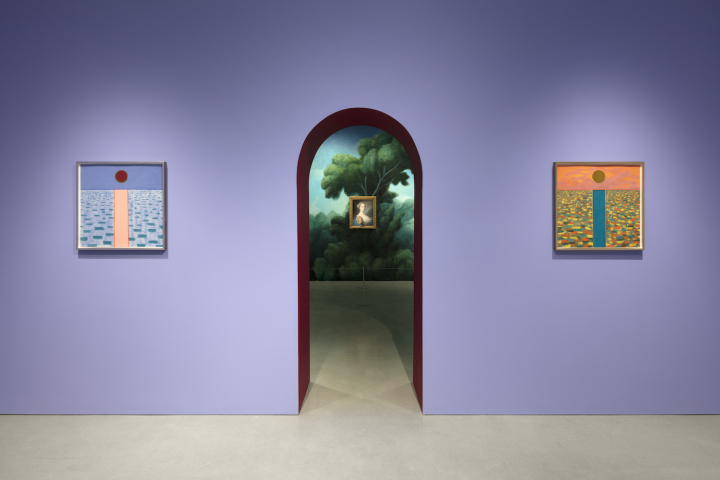
“Nicolas Party: Pastel” at The FLAG Art Foundation, installation view: Nicolas Party, “Sunrise” (2017), soft pastel on card, 23 1⁄2 × 23 5⁄8 inches, Private Collection (left); Rosalba Carriera, “Portrait of a Lady at Three-Quarter Length” (n.d.), pastel on paper, 22 × 17 1⁄4 inches, Collection of Nicolas Party (center); Nicolas Party, “Sunset” (2017), soft pastel on card, 23 1⁄2 × 23 5⁄8 inches, Private Collection (right)
Party presents his own work in context with pastels from the past three centuries, from circa 1720 through 2019, within a unique exhibition design marked by wall colors that bathe each gallery in an evocative, unexpected, at times breathtaking light. To hell with the white cube; this exhibition opens in bubblegum pink, where Party’s “Portrait with Pink Bows” (2019) radiates marigold.
The galleries’ dazzling hues, and stark transitions, were achieved with multiple applications of paint: nine coats on the magenta, five on the royal teal, and six on the British racing green. FLAG, a not-for-profit exhibition space on the ninth and tenth floors of the Chelsea Arts Tower, spared no expense. The galleries submerge you in such intense color that the air temperature seems to change from room to room, like Casa Luis Barragán in Mexico City, where the architect deployed color so powerful that it plays an active role in the building’s form.
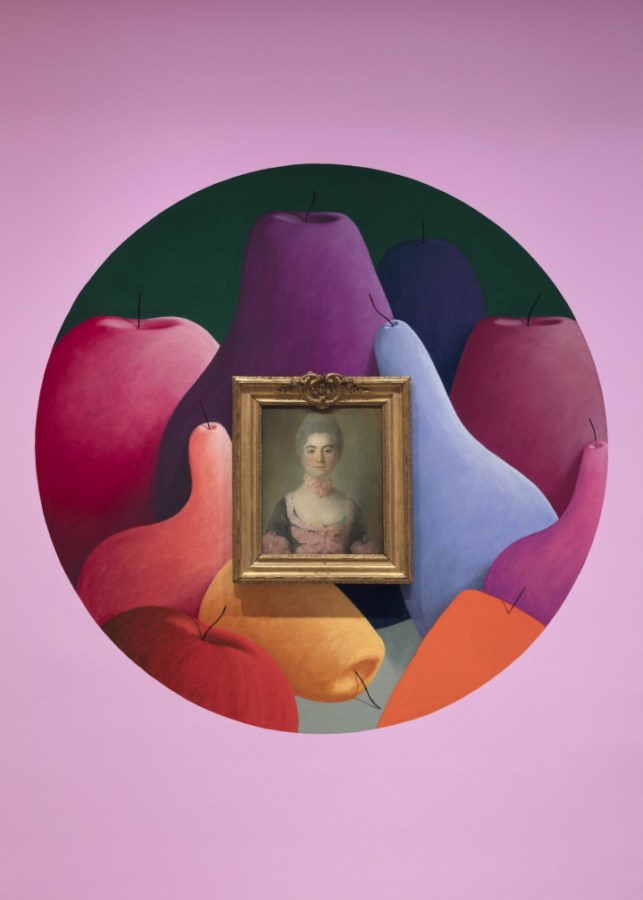
“Nicolas Party: Pastel” at The FLAG Art Foundation, installation view: Jean-Baptiste Perronneau, “Portrait of a woman with pink ribbons” (n.d.), pastel on paper, 17 5⁄8 × 25 5⁄8 inches, Collection of Nicolas Party (in frame); Nicolas Party, “Still Life” (2019), soft pastel on wall, diameter: 84 inches (mural)
Through a central archway attended by two of Party’s symmetrical landscape drawings framed in gold leaf-faced shadowboxes, you enter a kind of garden. Taking his cue from the immersive fresco from Livia’s Villa (1st century BCE), permanently on view at Palazzo Massimo in Rome, Party has covered three adjacent walls, edge-to-edge, floor-to-ceiling, in pastel. Trees and foliage fade into cumulus clouds against a blue sky.
The image is a detail from Jean-Honoré Fragonard’s iconic 1773 history painting, “The Progress of Love,” enlarged to a massive scale. You will remember this work from the Frick Collection. At the center of this 76 1⁄2-foot-wide, wraparound drawing, Party has hung a portrait by Rosalba Carriera (1675- 1757) in a gilt frame. The exhibition’s press release states that Party describes Carriera as the original source of the pastel portrait, and the centerpiece of this project. Opposite the Carriera hang two navy-blue Chris Ofilis decorated with shiny aluminum leaf.
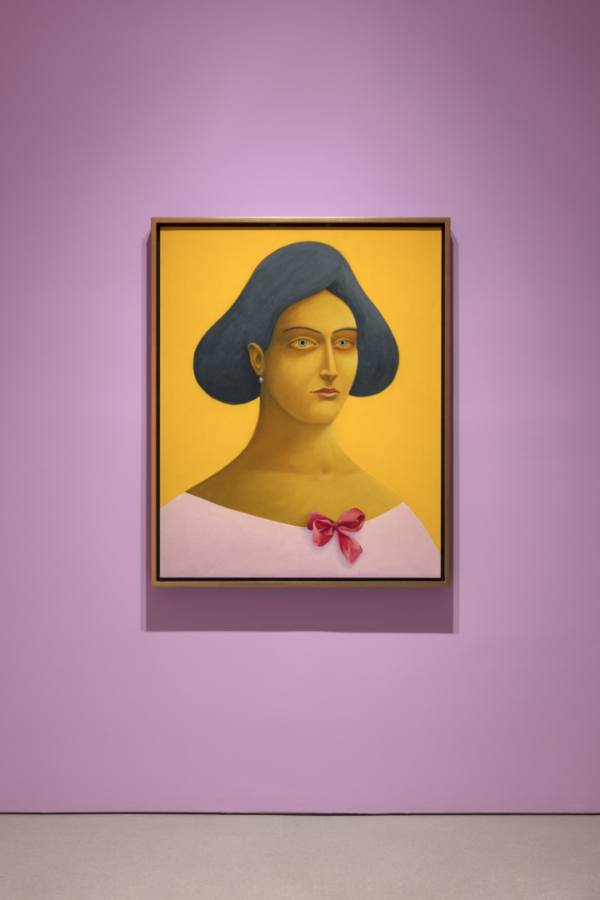 “Nicolas Party: Pastel” at The FLAG Art Foundation, installation view: Nicolas Party, “Portrait with Pink Bows” (2019), soft pastel on linen, 40 × 50 inches, courtesy the artist and Karma, New York
“Nicolas Party: Pastel” at The FLAG Art Foundation, installation view: Nicolas Party, “Portrait with Pink Bows” (2019), soft pastel on linen, 40 × 50 inches, courtesy the artist and Karma, New York
Party created four such site-specific wall drawings over the course of four weeks. After the FLAG space was redesigned and painted, the galleries were covered in plastic so the walls could be spray-coated with a mixture of gesso and cork dust. The resulting sandpaper-like texture was necessary for the dry pastel to adhere. With no way to preserve the wall drawings, they will be destroyed at the conclusion of the show.
Major museums have strict policies against the loan of pastels, which are too fragile to transport. So, Party secured the works by Carriera and Jean-Baptiste Perronneau (1715-1783), by purchasing them himself at auction (noted in the checklist). FLAG arranged the loan of the pastels by Mary Cassatt (1844-1926), Edgar Degas (1834-1917), and Marsden Hartley (1877-1943) from galleries and private collections.

“Nicolas Party: Pastel” at The FLAG Art Foundation, installation view: Louis Fratino, “Dolor” (2018), pastel on paper, 13 × 17 inches, courtesy the artist and Sikkema Jenkins & Co, New York (left); Marsden Hartley, “New Mexico Landscape” (1918-19), pastel on paper, 17 × 28 inches, Private Collection (right)
Pastels were highly coveted, collectible items from the 17th through the 19th centuries, and Party makes a compelling argument for the medium’s reexamination by exploring its value to young artists making work today. Louis Fratino’s preparatory studies isolate vignettes of boys on larger sheets of paper, rendered with a tender touch devoid of affectation. The fingerprints smudging the blank expanse of the paper suggest that he never thought anyone would see those areas.
One of the Fratinos hangs next to a Hartley landscape, the boy’s collarbones echoing the landscape’s rolling hills. Such adjacencies reveal the inspiration that the artists seek in one another, as Wayne Thiebaud looks to Degas.

“Nicolas Party: Pastel” at The FLAG Art Foundation, installation view: Mary Cassatt, “Mrs. Alexander J. Cassatt in Blue Evening Gown Seated at a Tapestry Frame” (n.d.), pastel on paper, 32 × 25 inches, courtesy of Acquavella Galleries (left); Billy Sullivan, “Mark 1984” (2008), pastel on paper, 52 × 44 inches, courtesy the artist and kaufmann repetto, New York/Milan
Billy Sullivan’s sexy male model, his arms draped in a turquoise off-the-shoulder, button-down shirt, speaks to Mary Cassatt’s woman in a turquoise evening gown: the two garments are virtually the same brilliant hue. Though separated by some 100 years, the two artists illuminate each other in a new context — Sullivan now somehow more classical, and Cassatt is refreshed.
In an exquisite navy-teal room straight out of Stephen Frears’s Dangerous Liaisons (1988), a squadron of resplendent geometric semi-abstractions by the young painter Loie Hollowell hang across from Edgar Degas’s “The Conversation” (1895), itself luminous on a wall of pink sateen shaded with umber and tinted like silk.
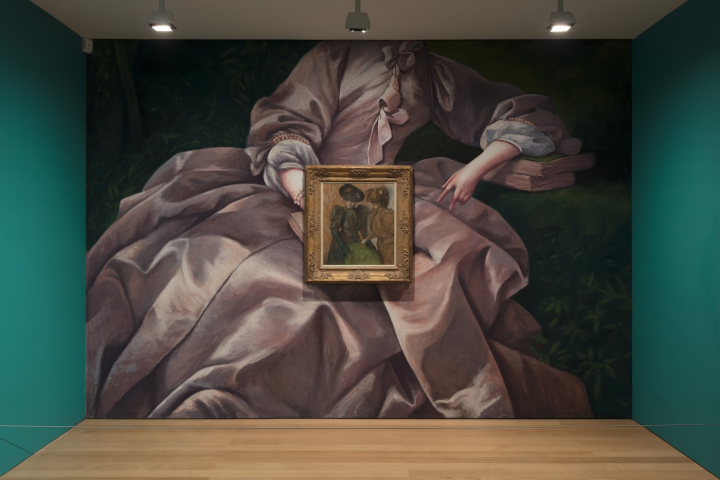
“Nicolas Party: Pastel” at The FLAG Art Foundation, installation view: Edgar Degas, “La Conversation” (1895), pastel on paper, 19 5⁄8 × 25 5⁄8 inches, courtesy of Acquavella Galleries (in frame); Nicolas Party, “From Françoise Boucher, Portrait of Madame de Pompadour, 1758” (2019), soft pastel on wall, 50 × 111 inches (mural)
The wall drawing reproducing the flowing mauve gown of a François Boucher behind the Degas predates it by almost 150 years, another juxtaposition orchestrated by Party’s unique eye. The exhibition’s final room is painted a canary yellow worthy of Versailles. Here, Robin F. Williams’ playful pastel “Alive with Pleasure (Study)” (2018), depicting two women and a man, all naked, frolicking on the beach, is framed against the luminous pink nude flesh of Rococo figures from Fragonard’s “Birth of Venus” (1753-55, now in the Musée Grobet-Labadié in Marseille), which vividly recalls Boucher’s 1740 painting, “The Birth and Triumph of Venus.”
In the first, pink room, the development of pigment concentrated into portable sticks, begun in the 16th century, is represented by a complete set of Henri Roché pastels presented in a 20-foot-long vitrine. The company dates back to the 1700s, and their chalk was Degas’ preferred brand ( it was harder than their competitors’). Pastel was developed originally as makeup, so portraits had a one-to-one relationship of sensual touch.
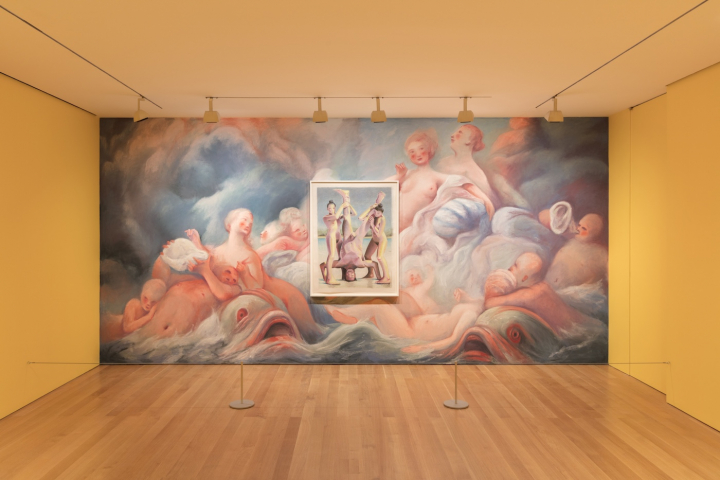
“Nicolas Party: Pastel” at The FLAG Art Foundation, installation view: Robin F. Williams, “Alive with Pleasure (Study)” (2018), pastel on paper, 51 × 38 1⁄2 inches,
courtesy the artist and P.P.O.W, New York (in frame); Nicolas Party, “From Jean Honoré Fragonard, Birth of Venus, 1753-55,” (2019), soft pastel on wall, 158 × 111 inches (mural)
Including one’s own work in a curatorial project is an almost universally acknowledged taboo, but Party handles it with dauntless grace. After several visits, I had to conclude that Party gets away with it because his work is just good enough to withstand the inevitable scrutiny, aided and abetted by the completeness of the exhibition design, the colored rooms, the collision between the very old and very new, and the skill with which they were recontextualized. The artist’s reverence for pastel is so profound, his knowledge and obvious love of contemporary and historical art so complete, that he transcends the faux-pas.
It is difficult to imagine a commercial gallery of any size — let alone a museum — would get behind Party’s ambitious project.Fortunately, FLAG, which is owned and operated by the “Top-200” collector Glenn R. Fuhrman — the founder of MSD Capital who retired just last week to focus on philanthropy — did not balk at the proposal. In fact, FLAG plans to release a fully illustrated catalogue, complete with a major essay by the art historian Melissa Hyde. Hidden in the middle of the Chelsea gallery district, this unique not-for-profit space, had the leeway to support, no questions asked, a freewheeling, spontaneous, and visually stunning exhibition that takes on an artist’s outlandish vision and runs with it.



